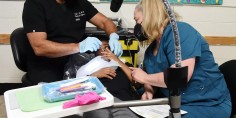Although telehealth services have long been an important part of South Carolina’s healthcare system, the COVID-19 pandemic underscored their role as a critical piece of the care delivery system.
That’s why the South Carolina Telehealth Alliance (SCTA) is excited to host South Carolina’s 5th annual Telehealth Awareness Week, September 19th-25th. The SCTA is a collaboration of many organizations working to expand telehealth across South Carolina. This year also aligns with the first-ever national Telehealth Awareness Week effort, thanks to the leadership of the American Telemedicine Association (ATA). Telehealth Awareness Week recognizes advancements in telehealth programs and policy, and promotes awareness of telehealth programs among health care providers, decision-makers, business leaders, and the general public.
Over the past decade, South Carolina has built a solid telehealth infrastructure that aims to leave no health system or citizen behind in accessing the opportunities afforded through technological innovation. Support from The Duke Endowment and others has allowed health care organizations in South Carolina to build their telehealth programs. Early telehealth initiatives such as the statewide telestroke network, the tele-ICU program, telepsychiatry programs, and school-based telehealth demonstrated how telehealth could successfully deliver high-quality care to patients experiencing access challenges. Those initiatives eventually helped prompt the South Carolina legislature to solidify its financial support for telehealth expansion, leading to the creation of the SCTA.
SCTA partners have worked tirelessly to develop key clinical telehealth programs, to create educational resources and training tools, and to build the technology and connectivity groundwork to support telehealth expansion statewide. This infrastructure allowed SCTA partners to adjust and pivot their resources quickly in response to the COVID-19 pandemic. While much of our day-to-day lives became physically isolated, South Carolinians were able to connect quickly with their providers to receive vital healthcare services in their homes via technology. During 2020, South Carolina providers completed over two million telehealth interactions, with more than 1.2 million visits taking place in real-time, directly to patients.
We are poised to emerge from this pandemic on a path to establish the most accessible health care in history. However, this will only come if we are intentional about how we optimize digital technologies to reach patients. It is essential that we work together as health systems, insurance providers, and citizens to ensure the right payment infrastructure is in place and that access to care is equitably distributed. This will require a focus on the rural and the underserved, including connectivity and availability of technologies. Importantly, it will require health systems to lead the way in partnering with their communities to establish a care continuum that works at the local level.








